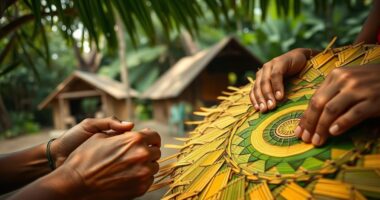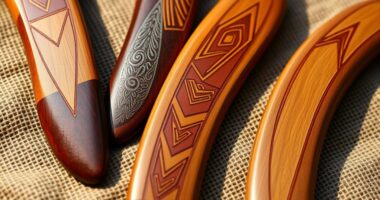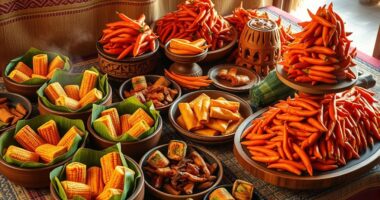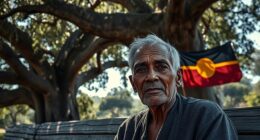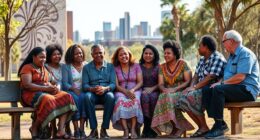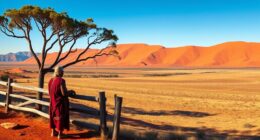Bush medicine connects you to nature through traditional plants, rituals, and spiritual practices. You learn to identify medicinal plants by their smell, shape, or color, choosing the best time for harvesting to guarantee their healing power. Rituals like singing or dancing strengthen the spiritual bond, activating the plants’ properties. This holistic approach emphasizes harmony with the environment and cultural heritage. Discovering more about these practices reveals a deep understanding of health rooted in centuries of tradition.
Key Takeaways
- Indigenous bush medicine relies on identifying plants through sensory cues like smell, shape, and color for effective healing.
- Traditional healing combines plant-based remedies with rituals to reinforce spiritual and emotional well-being.
- Harvesting practices emphasize sustainability, timing, and respect for environmental balance to preserve medicinal plant resources.
- Rituals, such as chanting and dancing, activate the healing properties of plants and strengthen spiritual connections.
- Cultural heritage and traditional knowledge integrate science and spirituality, forming a holistic approach to health and healing.
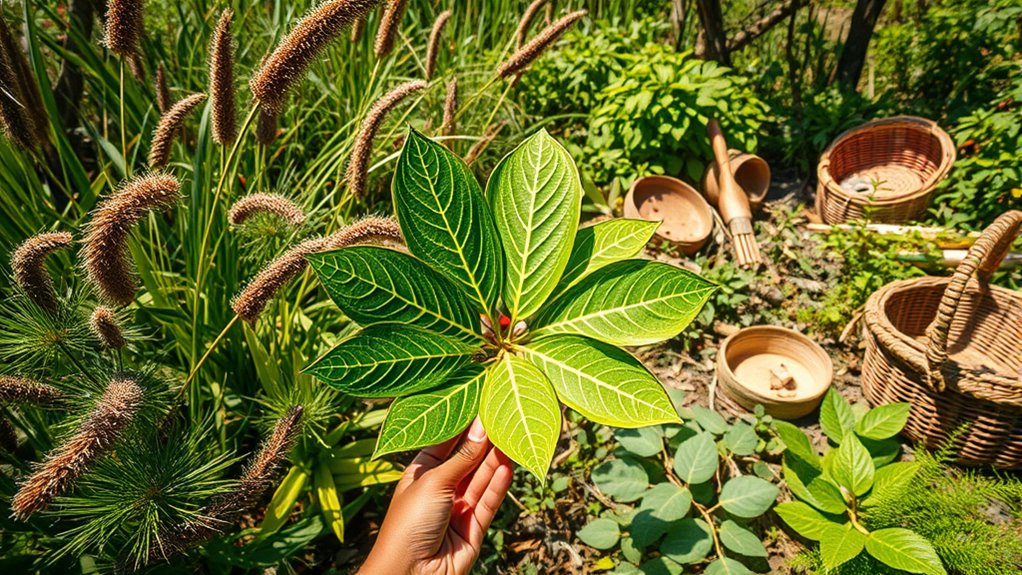
Have you ever wondered how indigenous communities have used the natural resources around them to treat ailments for centuries? It’s a fascinating blend of knowledge, intuition, and tradition that has been passed down through generations. One of the most vital skills in these communities is plant identification. By knowing which plants have medicinal properties, they can harvest the right herbs, leaves, roots, or bark needed for various treatments. This isn’t random; it’s a careful process of observation, experience, and understanding of the environment. For example, certain plants might be recognized by their unique smell, shape, or color, which signals their healing potential. Once identified, these plants form the basis of their bush medicine, used to alleviate everything from headaches to infections. The use of natural materials such as leaves, bark, and roots is fundamental in their preparations, emphasizing their connection to the environment.
Indigenous communities master plant identification to harvest healing herbs essential for traditional medicine.
But plant identification alone isn’t enough. These communities also integrate healing rituals into their practices. These rituals serve multiple functions—they reinforce the spiritual connection to the plants, invoke ancestral spirits, and create a sacred space for healing. The rituals often involve chanting, singing, or dancing, which are believed to activate the medicinal properties of the plants and align the healer’s energy with that of the patient. Sometimes, the healer may prepare a decoction or poultice from the identified plants during a ritual, emphasizing the spiritual significance of the act. The rituals also act as a form of psychological comfort, helping the patient to trust in the natural remedy and the healer’s knowledge.
You should understand that this combination of plant identification and healing rituals creates a holistic approach, addressing not just the physical ailment but also the emotional and spiritual well-being of the individual. The community’s deep respect for nature is evident in how they select and prepare their medicinal plants, often considering the right time of day or season for harvesting to maximize effectiveness. These practices aren’t just about curing illness; they’re about maintaining harmony between humans and nature. By integrating traditional knowledge with spiritual practices, indigenous healers preserve a cultural heritage that sustains their health systems and ecological balance.
Learning about bush medicine, especially plant identification and healing rituals, reveals a system of traditional knowledge that’s both practical and spiritual. It’s a proof to how indigenous communities have relied on their environment for centuries, blending science with spirituality to promote health and healing. So, when you explore bush medicine, you’re not just discovering remedies—you’re uncovering an entire worldview rooted in respect for nature and an understanding that healing involves body, mind, and spirit.
Frequently Asked Questions
Are Bush Medicines Scientifically Proven to Be Effective?
Many bush medicines haven’t undergone extensive scientific validation, but some show promise through clinical trials. You should know that scientific studies help confirm their effectiveness and safety. While traditional healing plants have been used for generations, you must be cautious and seek evidence-based information. Not all bush medicines are proven effective, so consulting healthcare professionals and looking for clinical trial results is essential before using them.
How Are Traditional Plants Sustainably Harvested?
You can guarantee sustainable harvesting by following conservation strategies that protect traditional plants. Always harvest responsibly, taking only what you need and avoiding overharvesting from wild populations. Use techniques like selective picking and rotating harvesting sites to allow plants to regenerate. Educate yourself on local regulations and traditional practices that promote conservation. By respecting nature’s balance, you help preserve these essential plants for future generations while benefiting from their healing properties.
Can Bush Medicines Interact With Modern Pharmaceuticals?
Think of bush medicines as delicate puzzle pieces—you need to fit them carefully with modern pharmaceuticals. Yes, they can interact, so you must consider plant toxicity and dosage safety. Always consult healthcare professionals before combining traditional remedies with medications. Ignoring these precautions might create unintended side effects, turning a healing journey into a risky adventure. Stay informed, cautious, and respect the power of both natural and modern treatments.
Are There Risks of Allergic Reactions to Traditional Remedies?
Yes, there are allergy risks and herbal sensitivities you should be aware of when using traditional remedies. Some plants can trigger allergic reactions, especially if you’re sensitive to certain herbs. Always test a small amount first and consult with a healthcare professional if you have known allergies. Being cautious helps prevent adverse effects and guarantees safe use of traditional healing plants alongside modern medicines.
How Do Indigenous Communities Preserve Their Medicinal Knowledge?
You can safeguard your community’s medicinal knowledge through cultural transmission, where elders teach younger generations about plants and practices. Additionally, plant conservation efforts help protect sacred species and ensure sustainable use. By documenting traditional methods and sharing stories, you keep this valuable knowledge alive. Engaging community members in conservation activities also reinforces the importance of maintaining these practices for future generations’ health and cultural identity.
Conclusion
You’ve learned that bush medicine isn’t just a tradition—it’s a crucial part of many cultures with over 80% of indigenous communities worldwide relying on these plants for healthcare. By understanding and respecting these practices, you help preserve invaluable knowledge and biodiversity. Embrace the healing power of nature, and remember, supporting traditional medicine can also contribute to maintaining cultural identity and ecological balance for future generations.


